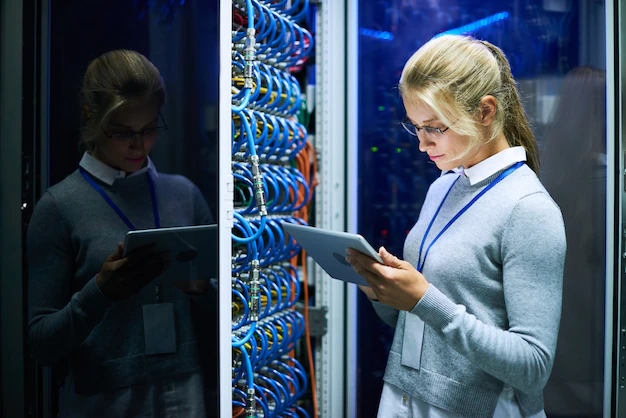
Data Center Checklist
A data centre is a facility in which computers and telecommunications equipment are housed.
Data centers have become more important with the ever-growing reliance on technology and are essential to companies that need to store or manage large amounts of data.
For this reason, it is important for businesses to have an accurate and up-to-date data center checklist. This checklist can help ensure that all important aspects of data center operations are considered.
No matter where you are with setting up or maintaining your data center, read our guide to understand what you should cover in your data center checklist.
In the article:
- Facility layout and design
- Power
- Cooling
- Data Storage and management
- Safety and physical security
- Creating a checklist for data centre operations
Facility layout and design
A data center’s layout and design is critical to its success.
The layout should be carefully planned to ensure that all equipment has the proper space and airflow.
The design should also take into account the cooling requirements of the data center, which includes:
- Airflow is a critical consideration. The hot air generated by the equipment must be properly managed to prevent overheating. The layout of the data center should be designed to ensure that the airflow is as efficient as possible.
- Equipment placement should be such that it allows for proper airflow. The equipment should also be placed in an area that is easily accessible for maintenance and repairs.
- Cabling infrastructure should be designed for flexibility. The cabling should be able to accommodate future expansions and changes
- Raised floor design. A raised floor allows air to flow underneath the equipment and helps to keep the equipment cool. The raised floor should be made of a material that will not create a fire hazard.
- Hot or cold aisle containment layout systems separate the hot and cold air in the data center in contained aisles to improve cooling efficiency. In hot aisle containment, the hot air is contained in an area near the equipment and the cold air is drawn in from the outside of the data center. In cold aisle containment, cold aisle is contained in an aisle and directed to equipment to cool it.
Power
Power is another of the most important aspects of data center operations.
The power supply must be reliable and able to handle the load of the data center.
The power distribution system should be able to provide power to all devices in the data center:
- Uninterruptible power supply (UPS). A UPS is a critical component of a data center’s backup power plan. The UPS maintains power to the data center in the event of a power outage. It also provides surge protection to protect the equipment from voltage spikes.
- Diesel generators. A data center should have a backup power plan in place such as diesel generators. The diesel generators should be able to provide enough power to keep the data center running. The generators should also be able to support the full load of the data center.
- Monitoring systems are important for monitoring the power supply. This system should be able to alert you if there is a problem with the power supply and provide information about the voltage and current levels of the power supply.
- Renewable power is becoming more important as the world focuses on going green. Renewable power options such as solar and wind can help reduce the reliance on traditional power sources. This may also prove to be more cost effective over
Cooling
Cooling is an essential part of data center operations.
Without it, the servers and other equipment could overheat and be damaged.
There are several factors to consider when cooling a data center:
- The amount of cooling required is determined by several factors, including the type of equipment, the number of servers, and the ambient temperature. The cooling system must be able to handle the load of the data center and maintain the desired temperature.
- The type of cooling system is also a The most common types of cooling systems are air conditioning and refrigeration. Air conditioning systems use fans to move the air around the data center. This air is then cooled by the AC unit and delivered back to the data center. Refrigeration systems use a refrigerant to cool the air. The refrigerant is circulated around the data center and absorbs the heat from the equipment.
Data storage and management
Data storage and management are essential components of any data center. The data center checklist should include a section on data storage and management.
When it comes to data storage, there are a couple of things to consider:
- The amount of storage required is the most important factor. You need to make sure that you have enough storage for your needs. You may also want to have a system that can be scaled up in the future to accommodate growth.
- Data storage configurations should also be considered. The three traditional configurations are direct-attached storage (DAS), which is a storage system attached directly to the servers, network-attached storage (NAS), a configuration accessible through a central system connected to the network and storage area network (SAN), which also allows you to connect through a network but with multiple access points.
Safety and physical security
Safety and physical security are important when it comes to keeping your data safe.
When it comes to data center security and safety, there are several things to consider:
- A fire suppression system is important for data centers. The most common types of fire suppression systems are water-based and foam-based. Water-based systems use water to extinguish the fire. Foam-based systems use a foam agent to extinguish the fire.
- Smoke detectors should be installed. The most common type of smoke detector is the photoelectric smoke detector. This type of smoke detector uses a light source and a photocell to detect smoke.
- Installing video surveillance in your data center might also be a good idea. Video surveillance can help you monitor the data center and ensure the safety of the staff and equipment.
- Incident management is the process of responding to and managing incidents that occur in the data center. The key processes are first identifying the incident, then assessing the risk then determining ways to minimize this risk.
Creating a checklist for data center operations
A data center checklist is important to ensure that all the necessary components are considered when designing and building a data center. It should include sections on cooling, data storage and management, network infrastructure, and safety.
A data center checklist should be carefully reviewed regularly to ensure that it is up-to-date. The checklist should be updated as new equipment is installed or changes are made to the data center. The checklist should also be updated when the company’s IT infrastructure changes.
If you are still looking for more information on data centers, like how to be an energy efficient data center, check out our info hub, updated with the latest data center content you need to know.
